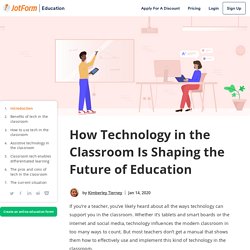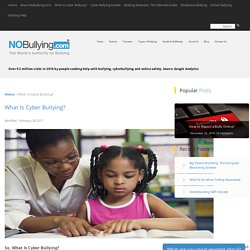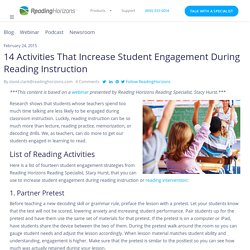

How Technology in the Classroom Is Shaping the Future of Education. Whether it’s gamification, online quizzes, or group collaboration, there are a near-infinite number of ways to use technology in the classroom.

The most effective educational technology applications use digital tools to meet specific learning objectives. Here are some of the most common ways teachers can enhance everyday lessons through strategies and lesson plans involving technology. 6 Scaffolding Strategies to Use With Your Students. What’s the opposite of scaffolding a lesson? Saying to students, “Read this nine-page science article, write a detailed essay on the topic it explores, and turn it in by Wednesday.” Yikes! No safety net, no parachute—they’re just left to their own devices. Let’s start by agreeing that scaffolding a lesson and differentiating instruction are two different things. Scaffolding is breaking up the learning into chunks and providing a tool, or structure, with each chunk.
What is Cyber Bullying ? So, What Is Cyber Bullying?

Cyber Bullying is the act of using the Internet, cell phones, video games, or other technology gadgets to send, text, or post images intended to hurt or embarrass another person. “It is also defined as acts of aggression through computers, cell phones, and other electronic devices” (Jackson & Cohen, 2012). Cyber Bullying can happen across several mediums such as: Social Networks such as Facebook, Twitter, Instagram, Youtube, MySpace, etc.Instant Messaging (IMs) and Text messaging.Email.Chat rooms/forums/blogs.Online Games. The spectrum of Cyber Bullying actions is very broad. Job and Internship Advice, Companies to Work for and More. The resume isn’t dead but it needs help.

In today’s online world, submitting a text document is no longer enough to stand out, especially as internships and new grad roles become increasingly competitive. A professional profile is the perfect way to share more about your interests, skills, and what makes you a unique candidate. Profiles have a number of benefits for student job seekers. 10 Exit Slip Prompts that Will Work for Any Class. If you’re not using exit slips, you really should try them. Basically, you give students a quick prompt at the end of class (or for elementary, at the end of the day or the end of a subject). Then the students have just a couple minutes to write an answer and turn it in. 14 Classroom Activities That Increase Student Engagement - Reading Horizons. ***This content is based on a webinar presented by Reading Horizons Reading Specialist, Stacy Hurst.*** Research shows that students whose teachers spend too much time talking are less likely to be engaged during classroom instruction.

Luckily, reading instruction can be so much more than lecture, reading practice, memorization, or decoding drills. 16 skills students need to learn today to thrive tomorrow. The gap between the skills people learn and the skills people need is becoming more obvious, as traditional learning falls short of equipping students with the knowledge they need to thrive, according to the World Economic Forum report New Vision for Education: Fostering Social and Emotional Learning Through Technology.

Today's job candidates must be able to collaborate, communicate and solve problems – skills developed mainly through social and emotional learning (SEL). Combined with traditional skills, this social and emotional proficiency will equip students to succeed in the evolving digital economy. What skills will be needed most? An analysis of 213 studies showed that students who received SEL instruction had achievement scores that averaged 11 percentile points higher than those who did not. And SEL potentially leads to long-term benefits such as higher rates of employment and educational fulfillment. License and Republishing. 3 Big Don’ts When Converting Instructor-Led Training to eLearning. With benefits like automation, consistent messaging, wider reach, and the ability to provide 24/7 learning, eLearning is an option that more and more companies have started to embrace.

But now what do you do with those PowerPoint slides that you created ages ago and had been delivering to your employees since then? If that training program is effective, don’t ditch it. You can convert it into an eLearning program without reinventing the wheel. But look out for these common mistakes that companies do when converting PowerPoint and Instructor-Led Training to eLearning because they don’t realize that eLearning and classroom learning are different: 1.
This is the most common mistake, and it stems from the belief that the PowerPoint slides contain learning matter for the learners. So, forget about madly converting PowerPoint slides from an ILT program into pages of an eLearning program. Why Your Students Don't Remember What You Teach - Why Your Students Don’t Remember What You Teach: The Overwhelming Power Of ‘Place’ In Learning by Terry Heick A decent question: Why don’t your students remember what you’ve taught?

Study Skills Guide: Improve Reading Comprehension Skills. Good reading comprehension comes only with practice.

The basic aspects of reading, such as word recognition, phonetics and fluence, can be mastered in just a few years. However, throughout this process reading comprehension must be emphasized. Students may be able to eloquently repeat the words that the see on a page all day, but without reading comprehension skills, they're unable to fully understand the content, predict what will happen next, recognize characters, gain insight or understanding to build upon, or relate what they're reading to their own life's experience. Sadly, classrooms across the United States have students who struggle with reading comprehension. Pearson Prentice Hall: eTeach: Strategies for Improving Reading Comprehension. By Patricia Babbitt Introduction Most Effective Strategies Practical Applications of Reading Strategies Summary Resources Remember the adventures that lived and breathed between the pages of a really good book when, as a young reader, you slipped away undiscovered into your own magical world?

My favorite works were Charlotte's Web, Arabian Nights, Huckleberry Finn, Arthurian Legends, and, later, the timeless tragedy of William Shakespeare's Hamlet. 8 Things to Look For in Today’s Classroom. As I think that leaders should be able to describe what they are looking for in schools I have thought of eight things that I really want to see in today’s classroom.

I really believe that classrooms need to be learner focused. This is not simply that students are creating but that they are also having opportunities to follow their interests and explore passions.1 The teacher should embody learning as well. Will Richardson recently wrote this in a comment on one of my recent posts on what teachers need to be like in our current day and the focus that needs to be on learning: …we need teachers who are masters at developing kids as learners who are adept at sense making around their own goals. Texas Educator Amy Storer Takes PBL to a Whole New Level.
Texas has a long history in the pantheon of computing, so it’s no mystery that Texas still creates thousands of computing jobs and will eventually need code-minded students to fill those. Montgomery, TX, educator Amy Storer – also a Tynker Blue Ribbon Educator – makes creativity in the classroom her focus. Along with other dedicated code-minded educators, Amy even moderated Monday’s #Tynkerchat on Twitter! Here’s a little more about Amy: Amy is graduate of Lamar University with a Master’s in Educational Technology Leadership. Education Week. —Courtesy of Allison Shelley/The Verbatim Agency for American Education: Images of Teachers and Students in Action By Anne Jolly If you want to engage students and get them excited about what they are learning in science, technology, engineering, and mathematics classes, ask them to tackle a real-world problem.
Then watch their amazement as they realize what they are learning in class actually has real-world applications. Working on solutions to real-world problems is the heart of any STEM investigation. These solutions may include devices and designs that improve our lives, fulfill our needs or wants, and make our world better. 7 Essentials for a Great Computing Course.
If you find yourself in the position of having to set up and run a new Computing course in school, where do you start? Here are seven factors that I consider to be essential. Safety first Everyone should feel safe in the classroom, not just from physical dangers such as trailing wires, but also from being shouted down or drowned out by other students (such as girls sometimes experience from the boys), being shown disrespect, or being subjected to the experience of stumbling upon racist websites or pornography, perhaps because of a lack of appropriate filtering. A Personal Cyberinfrastructure. © 2009 Gardner Campbell. The text of this article is licensed under the Creative Commons Attribution-NonCommercial-NoDerivs 3.0 License ( How To Make Students Better Online Researchers. Why Schools Need to Introduce Computing in All Subjects: Northwestern University News.
This article originally appeared in The Conversation on February 8, 2016. 5 Things That Should Be Taught in Every School. Schools are finally teaching what kids need to be successful in life — Quartz. Research shows that teaching kids things like perseverance and self-control can improve their health, academic achievement, and happiness in life. But teaching character, or social and emotional learning, has proven dicey.
The science was sometimes squishy, the curriculum often felt driven by those trying to set a moral agenda, and schools had too much else to do, like close the academic gap between high- and low-income kids, and the skills gap between US kids and some of their global counterparts. 4 Essential Rules Of 21st Century Learning. 4 Essential Rules Of 21st Century Learning by Jennifer Rita Nichols The term “21st century” has become an integral part of educational thinking and planning for the future. 5 Powerful Questions Teachers Can Ask Students.
5 Ways to Help Your Students Become Better Questioners. The humble question is an indispensable tool: the spade that helps us dig for truth, or the flashlight that illuminates surrounding darkness. Questioning helps us learn, explore the unknown, and adapt to change. That makes it a most precious “app” today, in a world where everything is changing and so much is unknown.
A Quick Guide To Questioning In The Classroom. How Teachers Can Become Fluent in Classroom Technology. During one of our last leadership team meetings this past school year, we reflected on our use of digital portfolios to house student work. We had a lot to celebrate: We had found a digital tool to capture student learning, Evernote, a cloud-based note-taking app. Teacher spends two days as a student and is shocked at what she learns. 5 Muhammad Ali Quotes Every Teacher Needs in the Classroom. Why Making Is Essential to Learning. Why We Need to Move Away from SMART Goals and Towards New Forms of Classroom Assessment.
How to Take Digital Citizenship Schoolwide During the 2016 17 School Year. 5 Classroom Tech Priorities for the Coming School Year. Middle School Maker Journey: Top 20 Technologies and Tools. 8 digital skills we must teach our children. Writing Learning Objectives for Technology Lessons. How to Integrate Technology. 6 Important Things To Know About How Your Brain Learns. Más allá de la regla “de 2 horas” con las pantallas: 10 consejos para la educación en la era digital.
Numbers Don’t Lie: Why Bite-Sized Learning is Better for Your Learners (and You too) 7 Games to Inspire a Child's Love for Reading. Better teachers? Better at what, exactly? 9 Elephants in the (Class)Room That Should “Unsettle” Us — Modern Learning. 21 Things That Will Be Obsolete by 2020. Never Too Young To Code. 5 Problems in Education That Technology Will Soon Solve. Transforming Teaching and Learning at an Early Age: EPISD Early Childhood Integration Model.
Why Finland has the best schools. 25 Ways to Develop 21st Century Thinkers. Explore the world without leaving your classroom. 7 Hi-Tech Education Trends to Watch for in 2016. 8 ways you can empower girls to learn coding. LEARNING LEADING CHANGE: Blue Sky High - five things every secondary school should implement...now. What Easter Island’s colossal stone statues teach about the dangers of modern school reform. 8 Things to Look For in Today’s Classroom. Schools Need to Include More Visual-Based Learning. 5 Tips for Teaching Digital Citizenship in the Elementary Classroom. Digital Reporting. Tech Tools That Have Transformed Learning With Dyslexia. 6 Truths About Technology in Education. Three Good Ways to Use All Those Pictures Students Take.
An education for the 21st century means teaching coding in schools. Education as it should be – passion-based. 60 Things Students Can Create To Demonstrate What They Know. Six Ways To Motivate Students To Learn. Google Apps For Education Now Has More Than 50 Million Users -
The 8 Minutes That Matter Most. Brainly, una plataforma de crowdsourcing para hacer tareasYoung Marketing. Six things kids need to succeed at school — but too many don’t get. How to Be More Open to Learning New Technology: 8 Steps. Redefining Learning Through Screencasting. Why Great Educators Need to be Great Storytellers. Say What? 5 Ways to Get Students to Listen. A Quick Guide To Questioning In The Classroom. 5 Ways to Help Your Students Become Better Questioners. 5 Powerful Questions Teachers Can Ask Students. 9 Ideas Education Is Having Trouble Responding To. Top 10 Tips To Create Effective eLearning Presentations and Slideshows. 6 Emerging Trends in Education and Mobile Learning. 7 Ed Tech Trends to Watch in 2014. Amazon launches AWS Educate to promote cloud learning. The Precious First Few Minutes Of Class.
Take aim at innovation, with students in the center. How Teaching Is Changing: 15 Examples. Coding from kindergarten to graduation. Finland schools: Subjects are out and ‘topics’ are in as country reforms its education system - Europe. 40 Uses For Smartphones in School. 10 Excellent New Educational Web Tools for Teachers. Teacher's Guide to Digital Storytelling. Which of these top 20 programming languages should your school teach? Harvard Graduate School of Education. Planning for Engagement: 6 Strategies for the Year. Science Shows You How To Raise Happy Kids. Why I Became a Connected Educator.